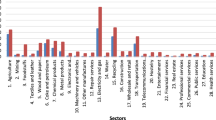Abstract
To fulfil its emission reduction target pledged in the Copenhagen accord, the Australian Government has determined to introduce a carbon tax from July 1st 2012. This paper simulates the effects on the environment and on the economy of a carbon tax of A$23 per tonne of carbon dioxide proposed by the government with, and without, a compensation policy. We employ a computable general equilibrium model with an environmentally extended Social accounting matrix. According to the simulation results, the carbon tax can cut emissions effectively, but will cause a mild economic contraction. Because the price signal is intact, the proposed compensation plan has little impact on emission cuts while significantly mitigating the negative effect of a carbon tax on the economy.
Similar content being viewed by others
References
ABS (1990) Australian national accounts: input-output tables, 1986–1987. Catalogue No. 5209.0, ABS, Canberra
ABS (2006) Household expenditure survey Australia, 2003–2004. Catalogue No. 6530.0, ABS, Canberra
ABS (2008) Australian national accounts: input-output tables, 2004–2005. Catalogue No. 5209.0.55.001, ABS, Canberra
Adams P (2007) Insurance against catastrophic climate change: how much will an emissions trading scheme cost Australia?. Aust Econ Rev 40(4): 432–452
Adams P, Dixon PB (1992) Disaggregating oil, gas and brown coal. Centre of Policy Studies, Monash University Mimeo, Melbourne
Adams P, Horridge M, Parmenter B (2000) MMRF-Green: a dynamic, multi-sectoral, multi-regional model of Australia. Centre of Policy Studies Working Paper No. OP-94
Ahammad H, Mi R (2005) Land use change modelling in GTEM–accounting for forest sinks. ABARE Conference Paper 05.13, ABARE, Canberra
Allen Consulting Group (2000) Greenhouse emissions trading. Report to the Victorian Department of Premier and Cabinet, Melbourne
Beausejours L, Lenjosek G, Smart M (1992) An environmental CGE model of Canada and the United States, fiscal policy and economic analysis branch. Working Paper, No 92-04, Department of Finance, Ottawa
Burniaux J, Martin J, Nicoletti G et al (1992) Green—a multi-sector, multi-region general equilibrium model for quantifying the costs of curbing CO2 emission. A technical manual, OECD Working paper, No.116, Paris
Centre of Policy Studies (2008) Model development and scenario design: MMRF modelling to support a study of the economic impacts of climate change mitigation. Report to the Australian Treasury
Cornwell A, Creedy J (1997) Measuring the welfare effects of tax changes using the LES: an application to a carbon tax. Empir Econ 22: 589–613
Devarajan S, Go D, Robinson S et al (2009) Tax policy to reduce carbon emissions in South Africa. Policy Research Working Paper WPS4933, The World Bank, Africa Region
Devarajan S, Go D, Robinson S et al (2011) Tax policy to reduce carbon emissions in a distorted economy: illustrations from a South Africa CGE model. BE J Econ Anal Pol 11(1): 1–22
Dixon PB, Parmenter BR, Sutton J et al (1982) ORANI: a multisectoral model of the Australian economy. North-Holland, Amsterdam
Hamilton K, Cameron G (1994) Simulating the distributional effects of a Canadian carbon tax. Can Public Pol 20(4): 385–399
Horridge M (2000) ORANI-G: a general equilibrium model of the Australian economy. Centre of Policy Studies/IMPACT Centre Working Papers op-93, Monash University
Labandeira X, Labeaga J, Rodriguez M (2004) Green tax reforms in Spain. Eur Environ 14: 290–299
McDougall RA (1993a) Short-run effects of a carbon tax. Centre of Policy Studies, General Paper No. G-100, Monash University
McDougall RA (1993b) Energy taxes and greenhouse gas emissions in Australia. Centre of Policy Studies, General Paper No. G-104, Monash University
The Treasury (2011a) Strong growth, low pollution–modelling a carbon price Commonwealth of Australia, Canberra
The Treasury (2011b) Securing a clean energy future—the Australian government’s climate change plan. Commonwealth of Australia, Canberra
Wissema W, Dellink R (2007) AGE analysis of the impact of a carbon energy tax on the Irish economy. Ecol Econ 61: 671–683
Zhang Z (1998) Macro-economic and sectoral effects of carbon taxes: a general equilibrium analysis for China. Econ Syst Res 10(2): 135–159
Author information
Authors and Affiliations
Corresponding author
Additional information
The authors would like to acknowledge funding from the Australian Research Council under Discovery Project DP0986306.
Rights and permissions
About this article
Cite this article
Meng, S., Siriwardana, M. & McNeill, J. The Environmental and Economic Impact of the Carbon Tax in Australia. Environ Resource Econ 54, 313–332 (2013). https://doi.org/10.1007/s10640-012-9600-4
Accepted:
Published:
Issue Date:
DOI: https://doi.org/10.1007/s10640-012-9600-4




